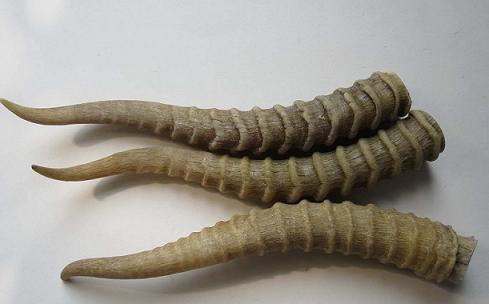Ling Yang Jiao
The Processing of Ling Yang Jiao
Origin
The horn of Saiga tatarica Linnaeus of family Bovidae.
Location
Xinjiang Autonomous Region, Gansu and Qinghai provinces in China.
Harvest
Collected during whole year, best in August and September.
One of main characterizations of Ling Yang Jiao is usually called "The eye reaching heaven”. It displays that when checking through lighting there is an ambiguous pore directing to the cusp of the horn at the upper half part of Ling Yang Jiao while the lower half part has been empty. In addition, the whole horn is semitransparent after the inner stuff is removed.
The actual smell and taste
No smell, light taste.
Best quality
Flexible, white, smooth, with blood streak and without crack.
Processing
The horns cut off, dried in the sun, shaved into thin slices or crush to powder unprocessed.
The Effect of Ling Yang Jiao
Property
Salty, cold; liver and heart meridians entered.
Actions
Extinguish wind and stop spasm, pacify liver and subdue yang, clear liver heat and improve vision, clear heat and relieve toxicity.
Indications
A. Syndrome of stirring of liver wind
It is the key herb for stirring of liver wind, fright epilepsy and convulsions especially for generation of wind by extreme heat because it has actions of extinguishing wind and stopping spasm, and clearing liver heat. For generation of wind by extreme heat in warm diseases with symptoms such as high fever, coma, spasm and convulsions, it is often combined with liver-heat clearing, liver-pacifying and wind-extinguishing herbs. For instance, it is combined with Gou Teng, Ju Hua and Bai Shao, etc, in Ling Jiao Gou Teng Tang from Tong Su Shang Han Lun (Popular Treatise on Cold-Induced Diseases). For epilepsy due to phlegm heat and infantile convulsions, it is often combined with resolving phlegm for resuscitation herbs, wind-extinguishing and spasm-stopping herbs, such as Gou Teng, Tian Zhu Huang and Niu Huang, etc.
B. Liver yang hyperactivity, dizziness, blurred vision
Being salty and cold with heavy characteristics tit has action of pacifying liver and subduing yang. For dizziness, blurred vision, restlessness and headache due to liver yang hyperactivity, it is often combined with yin-nourishing herbs and liver-pacifying and yang-subduing herbs, such as Gui Jia, Shi Jue Ming and Ju Hua, etc.
C. Blood-shot eyes, headache due to up-flaming of liver fire
It is good at clearing and purging liver fire, so it is indicated for up-flaming of liver fire with such symptoms as headache, dizziness, blood-shot eyes with swelling and pain, photophobia, dacryorrhea, etc. It is combined with liver-clearing and fire-purging herbs, such as Long Dan Cao, Jue Ming Zi and Huang Qin and so on.
D. Epidemic warm diseases with high fever, coma, macula due to heat toxin
Being salty and cold with the actions of clearing heart and liver and purging fire and relieving toxicity, it can clear heat in qi and blood systems. For epidemic warm diseases with coma, high fever, mania and convulsions, it is often combined with herbs to clear heat, relieve toxicity, stop spasm and induce resuscitation. For instance, it is combined with Shi Gao, Han Shui Shi and She Xiang, etc. in Zi Xue Dan from Bei Ji Qian Jin Yao Fang. For macula due to heat toxin, it is often combined with heat-clearing and blood-cooling herbs, such as Xuan Shen and Sheng Di Huang.
Dosage and Administrations
Decoct 1~3 g. Decoct singly for more than 2 hours for orally taking. Make into powder with water to get liquid, or grind into powder, 0.3~0.6 g each time.
